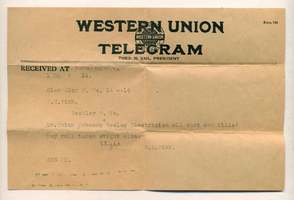 | Back to e-WV
| Back to e-WV
 The West Virginia Encyclopedia
The West Virginia Encyclopedia
 | Back to e-WV
| Back to e-WV
 The West Virginia Encyclopedia
The West Virginia Encyclopedia

On the morning of August 14, 1914, when a Norfolk & Western train arrived at Glen Alum station in Mingo County, it carried the usual $7,000 cash payroll for the Glen Alum Coal Co. The arrival of the money, dispatched from a bank in Lynchburg, Virginia, set in motion one of West Virginia’s biggest – and bloodiest – crime stories.
The payroll money was transferred from the train to a gasoline-powered N&W handcar to travel the spur track leading to the coal company offices several miles up Glen Alum Creek.
Three men boarded the handcar with the money – Dr. W. D. Amick, company physician; F.D. Johnson, bookkeeper, and Joseph Shielor, a company electrician who operated the car. Somewhere between the depot and the coal company offices, the men spotted a barricade of railroad ties or logs blocking the track.
As they stopped to clear the track the men were struck down in a barrage of bullets fired by a hidden gang of bandits. All three of the men fell, dead or dying. The gunmen grabbed the payroll money and fled.
Concerned about the handcar’s failure to arrive, an official at the mine office phoned the station agent and was assured it had left on schedule. A short time later, a teamster who had been hauling supplies to the mine burst into the office and reported he had happened on the handcar and its three passengers – two dead and one dying.
Word of the triple murder and payroll robbery was sent to Mingo Sheriff Greenway Hatfield, a nephew of Devil Anse Hatfield, at his office in Williamson, 30 miles away. Soon the sheriff and a heavily armed posse arrived at Alum Creek aboard a special N&W train.
What followed was a mammoth manhunt. The original posse numbered somewhere between 25 and 50 men. But as news of the crime spread, mines and sawmills were forced to shut down when workers put down their tools, picked up their guns and set off in search of the outlaws. This increased the size of the manhunt to hundreds of men.
After a lengthy search, the posse cornered the outlaws in a rocky ravine known to locals as Shanty Hollow. A fierce gun battle ensued, with more 1,000 shots exchanged. Three of the posse members were killed and two others wounded. As the standoff dragged on for hour after hour, charges of dynamite were used in an unsuccessful effort to dislodge the outlaws.
Finally, on Sunday morning, August 16, when the posse charged the outlaws’ lair, they found four of the men dead and the fifth dying. All five were strangers. Their bodies were carted off to Williamson where they were put on display in their coffins and then buried in unmarked graves. The dead outlaws appeared to be Italian and unfounded rumors circulated they were members of the Black Hand, a secret society of Italians that preyed on their fellow countrymen.
The blood-stained $7,000 was recovered – all but $20 of it, which was mysteriously missing.
Written by James E. Casto